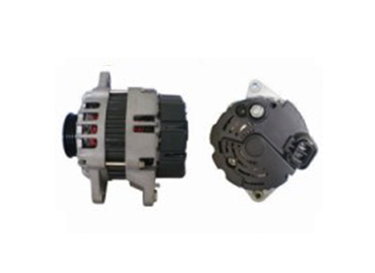Jan. 14, 2020
With the advancement of automobile technology, the power consumption of automobiles is getting higher and higher. Twenty years ago, the output power of a mid-range car's generator was generally only about 500 watts. Now, the average power of a mid-range car's generator is about 1,000 watts. The increase in generator power increases with the increase in electrical equipment on the vehicle. The generators on cars are all air-cooled generators. The fan behind the pulley blows into the casing for cooling. Under the limitation of the existing air-cooled generator structure, an increase in power will inevitably lead to an increase in the volume of the generator.
At the same time, increasing the fan size to increase the degree of cooling will increase the noise. Aiming at the contradiction between the existing automobile spare parts and the increase in power consumption, some people have proposed a solution for water-cooled alternators.
Alternator for trucks use water instead of fans for cooling. The main heating part of the alternator is the stator, and the main cooling part of the water-cooled alternator is the stator and the coil winding. The front and rear covers of the generator are made of aluminum and have a water channel slot. The stator and coil windings are fixed and sealed with synthetic resin, and there is an aluminum enclosure between the stator and the rotor to isolate it from the water channel. The water channel communicates with the water inlet pipe and the water outlet pipe, and the water inlet pipe and the water outlet pipe communicate with the engine cooling water system, respectively.
In this way, when the engine is running, the cooling water is circulated by the engine water pump. Through the generator housing, the stator coil windings and stator cores can be effectively cooled. At the same time, the rotors, built-in regulators, and bearings are also cooled.

Alternator For Trucks
Compared with the air-cooled alternator, the water-cooled alternator has a more complicated internal structure, increased leak-proof sealing requirements, and increased costs. At the same time, due to the problem of connecting water pipes, the installation arrangement is also limited, and the degree of freedom is reduced. However, the power generation and low noise performance of water-cooled alternators cannot be compared with air-cooled alternators.
First, the water-cooled alternator has good low-speed charging characteristics. We know that there is an "inflection point" on the alternator's current characteristic curve, that is, the current will not be generated until the so-called "0 amp speed" is exceeded, and the current can be charged to a certain degree. At which speed does the "knee" appear and the charge current is related to the magnitude of the magnetizing current. Since the water-cooled alternator greatly suppresses the temperature rise of the stator, rotor, and regulator, the excitation current can be increased accordingly. The larger the excitation current, the higher the output voltage. Therefore, the water-cooled alternator will also perform well when rotating at low speed The low-speed charging performance is very important for the normal use of urban cars.
Second, the water-cooled alternator has low noise. Because the fan is omitted, there is no noise from the generator fan. According to reports, at 3500 rpm, the water-cooled alternator is 15 dB lower than the air-cooled alternator.
Third, the advantages of water-cooled alternators are optimistic, which is considered to be the development direction of china's modern hyundai alternator supplier. Some people think that in 12 volt cars, air-cooled alternators below 2500 watts are suitable, and water-cooled alternators above 2500 watts or 42 volts are suitable.
Navigation
Name: Carrie Zhou
Tel: +023-68886580
WeChat: 0086-13650592877
E-mail: carrie@autopartstf-ws.com
Skype: transfortune
WhatsApp: +86 136 5059 2877
Homepage: www.autopartstf-ws.com